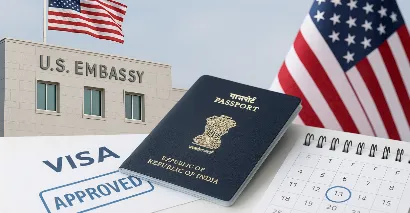Key Highlights
Gaining approval for a U.S. visa is often the final hurdle in realizing a dream of travel, study, or work in the United States. However, the process of securing the necessary interview and biometrics appointments can feel like navigating a complex maze. With high demand and limited slots, understanding the exact, authorised procedures for initial booking, strategic rescheduling, and requesting an emergency slot is vital for every applicant. The U.S. government has a precise, multi-step system in place, and straying from this official path—or making a simple mistake—can lead to costly delays or outright rejection. This comprehensive guide breaks down the official, step-by-step process, providing you with the necessary roadmap to secure your appointment efficiently and securely.
Also Read: US Immigration: Everything You Should Know Is Here
The Critical Pre-Requisites for Application Success
Before an applicant can even begin the process of selecting a date on the calendar, there are two mandatory documentation and financial steps that must be completed. These steps establish the official foundation of your application and generate the unique identifiers required by the scheduling system. Without these two elements, the scheduling platform will not permit you to proceed, halting your progress before it even starts.
The Cornerstone of Your Application: DS-160 and Fee Payment
The DS-160 is the non-immigrant visa application form, an extensive online document that serves as the primary record of your intent, background, and eligibility. Completing and submitting this form is paramount, as the DS-160 confirmation number becomes a non-negotiable credential for accessing the appointment system. Accuracy here is critical; any discrepancy between the information on your DS-160 and your passport or the details entered during scheduling can lead to delays or issues at the interview stage.
Furthermore, the mandatory Machine Readable Visa (MRV) fee must be paid and cleared. Applicants must ensure they keep the fee receipt and the DS-160 confirmation page readily accessible, as they are the keys that unlock the subsequent scheduling phase. The payment process itself is often separate from the booking portal, involving various accepted banking methods, and it's essential to wait for the system to register the payment before attempting to proceed to the next step.
Navigating the Official US Visa Scheduling Portal
The entire appointment process is centralised through one official platform. This website acts as the gateway where your DS-160 application merges with the consular schedule. It is designed to be the single, secure channel for all booking, rescheduling, and status tracking activities. Applicants should never attempt to use third-party or unofficial services that claim to offer better access, as this often leads to fraud and the complete loss of their application fees and eligibility.
Also Read: US Visitor Visa B1/B2
Establishing Your Secure Applicant Profile
To initiate the scheduling process, every applicant must create a unique and secure profile on the official website. This profile is not just a placeholder; it is the secure container for all your sensitive personal and application data. To protect your information and application integrity, the system mandates stringent security measures. You must create a unique username and a password that is between 8 and 16 characters long. This password must be complex, requiring at least three of the following four character types: lowercase letters, uppercase letters, numbers, or symbols.
The system also requires a frequently used email address for all official communication and a two-factor verification step where a code is sent to that email to verify ownership. The applicant must carefully complete the name request box to ensure it is an exact match to the name on their passport. A final layer of security involves answering three security questions, which are critically case-sensitive and necessary for future logins or password resets. This thorough approach to profile creation is designed to prevent unauthorised access and protect applicants from potential identity theft or exploitation by fraudulent entities.
Utilising an Existing Profile and Password Recovery
It is a common error for applicants who have previously applied for a visa to attempt to create a new profile, believing their old one is obsolete. However, applicants who already have an existing profile are strongly advised against creating a new one. The existing account should be the primary point of entry for all subsequent applications and management. Creating a duplicate profile can confuse the system, lead to application errors, and potentially complicate fee tracking, as the MRV fee is tied to the original applicant data.
Therefore, if you have an existing profile but have forgotten your credentials, the process is streamlined for recovery. You can easily reset your password using the system’s automated tools, which sends a password reset link to your verified email address. This recovery mechanism relies on the verified email provided during the initial setup and is far more reliable and efficient than starting from scratch, which could lead to administrative conflicts.
Also Read: Intracompany Transfer Visa USA
The Two-Step Visa Appointment Booking Process
The U.S. visa appointment process is unique because it requires applicants to book not one, but two separate dates: one for biometrics collection and one for the consular interview. This two-part approach is designed to separate the administrative collection of data from the critical, substantive review of the application by a Consular Officer.
Selecting Visa Type and Categorisation
Once your profile is active, the first substantive step is to identify the type of visa you are seeking correctly. This involves distinguishing between an immigrant visa (for permanent residency) and a non-immigrant visa (for temporary stays). For non-immigrant visas, you must then select the specific category, such as a Visitor Visa (B-1/B-2), a Student Visa (F-1), or a Temporary Work Visa (H-1B, L-1). Correct categorisation is crucial, as availability and requirements vary significantly by visa type.
The next screen will require you to input all of your essential details, including your passport number, date of birth, nationality, and, most importantly, the DS-160 confirmation number. This is where the initial preparatory work pays off, as the system validates your information against the pre-filled application data.
Booking Biometrics (V) and Interview Appointments
It is important to understand that the process requires two appointments: the V appointment, which stands for Visa Application Centre (VAC) appointment, and the Interview appointment at the U.S. Embassy or Consulate. The V appointment is dedicated to administrative tasks, primarily collecting your fingerprints (biometrics) and taking your photograph. This usually happens a few days before the actual interview. The interview appointment is the official meeting with a Consular Officer who will review your application and determine your eligibility.
A key benefit of the system is the flexibility it offers regarding location. While there are five visa application centres in India, you are allowed to book these two appointments—the V appointment and the interview—at different locations if it suits your travel logistics or if appointment availability is better in varied cities. Applicants should therefore check availability across all locations to find the earliest dates possible, as slots open on a rolling basis.
Managing Dependents and Large Group Applications
The system is designed to facilitate family and group travel efficiently. If you are applying with your immediate family, you can utilise the “manage dependent” tab within your profile. This allows you to link the applications of your spouse and minor children to your own, ensuring that the entire family unit can be scheduled for appointments together. This coordinated scheduling is vital for family unity and simplifies the logistical challenge of booking multiple concurrent appointments.
However, for very large groups, specifically those of 10 or more travellers, a separate, dedicated group appointment guidance process must be followed. This is typically for large delegation teams, school groups, or corporate transfers, and the process accounts for the logistical strain a large booking places on the consulate's capacity. Consulting the official group appointment guidelines is mandatory for these larger applications to avoid being flagged or having the appointments denied due to misuse of the standard family booking feature.
Also Read: Difference Between B1 and B2 Visa USA: Experts' New Guide
Strategic Rescheduling and The Emergency Request Protocol
Mistakes happen, or circumstances change, necessitating a need to shift a pre-booked date. However, the U.S. scheduling system enforces strict rules on changes, which applicants must understand thoroughly to avoid permanently jeopardising their application.
The Single-Reschedule Limit and No-Show Penalty
Applicants must exercise extreme caution when initially booking their appointments, as the U.S. Embassy in India clearly states that each appointment can only be rescheduled once. This one-time limit is a significant restriction, meaning that if you use your single chance to reschedule and then must change the date again, you may find yourself locked out of the system.
This single-reschedule rule is further compounded by the severe penalty for missing a confirmed date. If an applicant fails to appear for their scheduled interview or biometrics appointment—a status known as a no-show—they are considered to have forfeited their application slot and must restart the entire process. This means paying the visa fee again, completing any necessary new forms, and returning to the beginning of the queue, which could result in months of delay.
Qualifying for an Expedited Emergency Slot
For applicants facing truly exceptional and urgent circumstances, the U.S. Embassy offers expedited, or emergency, appointment slots. It is crucial to understand that these slots are reserved for genuine, life-or-death emergencies and are granted on a case-by-case basis under very strict criteria.
The primary requirement is that the applicant must first book a regular appointment before submitting an emergency request form. This ensures that the applicant has completed all prerequisites and is a legitimate contender in the queue. Examples of qualifying emergencies are strictly limited to situations such as the death of an immediate family member (parent, spouse, child, sibling) requiring urgent travel for funeral arrangements, or the need for urgent medical treatment that cannot be deferred or obtained locally.
The applicant must be prepared to submit documentary evidence—such as a death certificate or a letter from an Indian physician detailing the critical need for immediate treatment abroad—to substantiate their claim, as requests lacking sufficient evidence will be denied.
Avoiding Pitfalls and Seeking Legitimate Support
The complexities of the scheduling process, unfortunately, make it a target for opportunistic individuals and fraudulent agents. Applicants are strongly advised to be wary of any third-party entities that promise guaranteed, fast-track appointments for an extra fee. The only legitimate fees are those required by the U.S. government for the MRV application.
Applicants are responsible for ensuring that all information submitted is accurate and truthful. If help is needed with the technical aspects of the website, support should only be sought from trusted family members or friends. The official channel for technical assistance is available via email at support-india@uscheduling.com, the website's chat function, or by calling the official help desk in India at +91 20 6902 0000. Utilising these official channels protects your privacy and ensures you receive accurate guidance directly from the authorised source.
Conclusion
Successfully navigating the U.S. visa appointment process requires a blend of diligence, preparation, and adherence to official protocol. By meticulously completing the DS-160 and fee payment, creating a secure profile on the official scheduling portal, and understanding the critical two-step booking system, applicants can significantly minimise delays.
Furthermore, respecting the strict one-time rescheduling limit and reserving the expedited request mechanism for only genuine, documented emergencies are non-negotiable elements for a smooth application journey. Adopting a careful, fraud-aware approach will ensure the integrity of your application, paving the way for your successful and timely interview. Visit TerraTern now to learn more!






